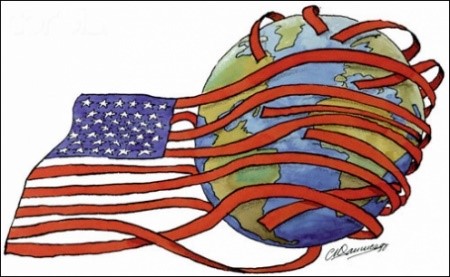Cold War and the American Dominion in the Middle-east
By Noorah Jukaku
“The period that is always most difficult of access is the one that is just within living memory. Not yet written down, its’ primary sources often still inaccessible, it is at the disposal of fallible memory and prejudice. No generation is ever fair to its parents.”(Hill, 2008, p.23)
For over several decades, the U.S. dominance and influence in the Middle East has been a controversy. It is a form of ongoing colonialism, both physical and cultural, even though it is not often viewed to be so. I would like to discuss some aspects of the dominance of the U.S over the Middle East, a concise history of its’ beginnings post World War II and the Cold war rhetoric fueled by the Superpowers to motivate the Cold War that helped frame the affairs of the world.
Cold War Rivalry and Beginning of US Dominance in Middle East
“For nearly half a century, the Cold War rivalry between the United States and the Soviet Union created a glacial divide that loomed over international relations. Its icy tentacles extended across the globe, with often devastating effects.
The Cold War provoked a high degree of polarization, as states and political parties aligned themselves with the two superpowers in virtually every region of the world, exacerbating and aggravating preexisting local conflicts or producing new ones, and envenoming the political atmosphere in numerous countries.
Once it became a full-blown ideological and great-power confrontation in the wake of World War II, the East-West division dominated deliberations at the newly established United Nations and became the main focal point of international affairs. Its chill was felt in the domestic politics not only of the United States and the Soviet Union but of countries over the world.
The Cold War did not begin immediately after World War II, although precisely when it did start is a subject of some dispute. Former British Prime Minister Winston Churchill’s famous observation, in a speech at Westminster College in Fulton, Missouri, on March 5, 1946, that “from Stettin in the Baltic to Trieste in the Adriatic, an iron curtain has descended across the Continent,” is often seen as a decisive indication that the Cold War was already under way by that point, less than a year after the war’s end.” (Khalidi, 2009, pg.1–2).
The Cold war rivalry between the U.S and the USSR, began post World War II which affected and created tension in many countries around the world. Prior to the World War II, the rivals weren’t acquainted with the geographical significance of the Middle East and establishing military bases was even more farfetched. Its’ importance, however, became eminent during the World War II, and each tried to gain supremacy. Although the Cold War came to an end per se, the haunting after effects remained and the best example would be a study of the Middle East.
“Immediately subsequent to the rapid disappearance of its Soviet rival, in 1990–91, the United States engaged in an extraordinarily confident assertion of its suddenly unrivaled power in the Middle East via its leadership of a grand coalition against Iraq’s invasion of Kuwait in the Gulf War of 1991, and in convening the 1991 Arab-Israeli peace conference in Madrid, which led to the 1993 Oslo Accords, signed on the White House lawn.
Both were unprecedented initiatives in various ways. Although nominally a collective effort, the 1991 Gulf War was the first American land war in Asia since Vietnam. Meanwhile, Madrid witnessed the first multilateral peace conference in history bringing together all the parties to the conflict, Arab and Israeli, and all relevant international actors. Moreover, it constituted the first and only serious and sustained American (or international) effort in over half a century at a comprehensive resolution of the Palestine conflict.” (Khalidi, 2009, pg. 6–7).
With the fall of its’ rival, the Soviet, and the expanding power and influence of the United States becoming eminent, America set its’ interests in the Middle East first by playing a significant role in invasion of Iraq in Kuwait which marked the first American land war in Asia after Vietnam. Ironically, it even took part in the resolution of the Palestine while later also being a grand supporter of the Israeli occupation of Palestine.
The motives behind its interest in the Middle East were and currently are greatly apparent.
The presence of the world’s largest oil reserves as well the geographical significance of the area was what aroused its interests in the region. After the World War II ended, the demand for oil increased and America gradually exhausted its domestic resources.
“As U.S. oil companies joined the global search for new sources, geologists came to believe that two-thirds of the world’s exploitable oil reserves and one-third of its natural gas lay under a handful of states bordering on the Persian Gulf. As a result, the security of Gulf oil states became of paramount concern to U.S. military planners.” (Forbes.com, Thompson, 2012).
A current statistics from OPEC share of world crude oil reserve states that: “81.99% of the world’s proven oil reserves are located in OPEC member countries, with the bulk of OPEC oil reserves in the Middle East, amounting to 65.36% of the OPEC total.” (OPEC Annual Statistics Bulletin 2018).
America’s establishment of air bases in Dhahran, Saudi Arabia along with other Arabian countries later on became an outset of permanent presence in the region that is ongoing until this day. The early and Post World war strategies used by the U.S to gain control over the region makes it’s a strong influencer, and supreme power in the Middle East along with being an exclusive authority of global hegemony.
| Noorah Jukaku is masters student in the Department of Humanities and Social Sciences in National Chiao Tung University Taiwan. |



